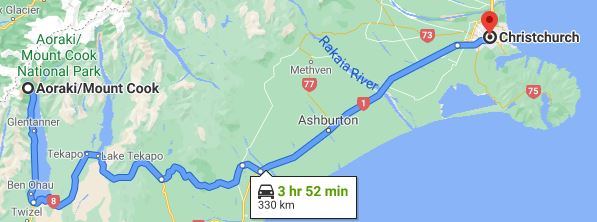 Having drunk nothing stronger than ice water and gone to bed before midnight the previous evening, our group of five full-time senior missionaries was able to get a reasonably early start on the first day of 2021. By 8:30 a.m. we were in the van, heading back down the west side of Lake Pukaki. Our appetites still sated from the New Year’s Eve buffet, we decided to skip breakfast in Aoraki/Mount Cook Village and instead stop for brunch in Lake Tekapo, which we reached about 9:45.
Having drunk nothing stronger than ice water and gone to bed before midnight the previous evening, our group of five full-time senior missionaries was able to get a reasonably early start on the first day of 2021. By 8:30 a.m. we were in the van, heading back down the west side of Lake Pukaki. Our appetites still sated from the New Year’s Eve buffet, we decided to skip breakfast in Aoraki/Mount Cook Village and instead stop for brunch in Lake Tekapo, which we reached about 9:45.
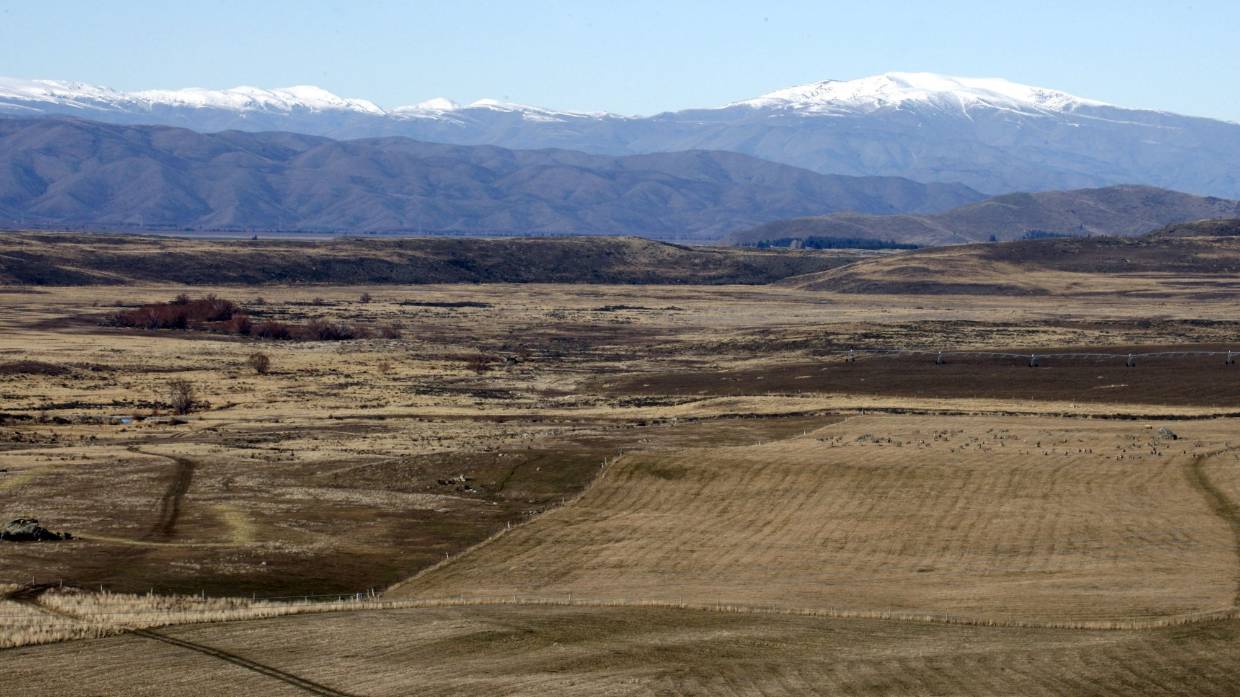
Mackenzie Basin
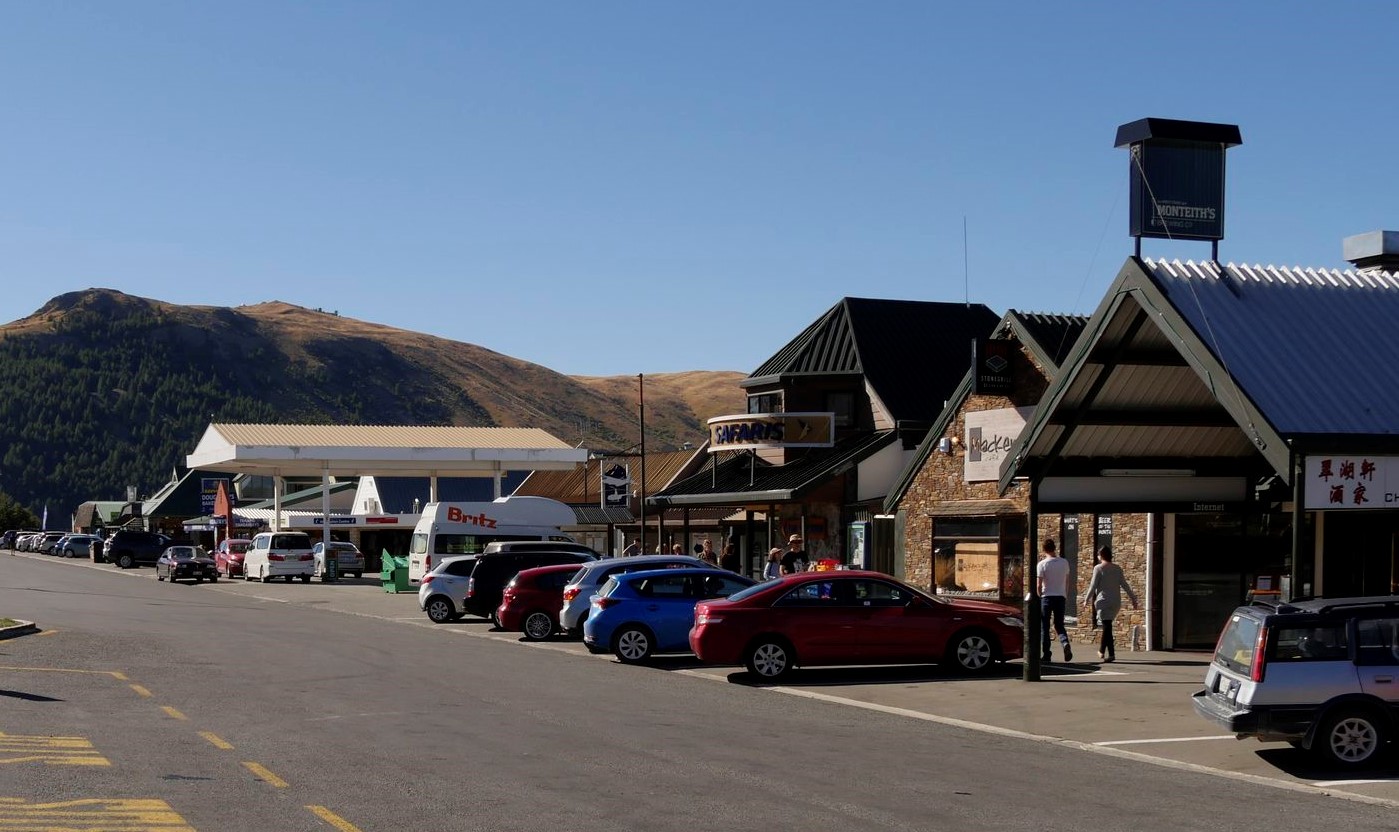
Lake Tekapo Village
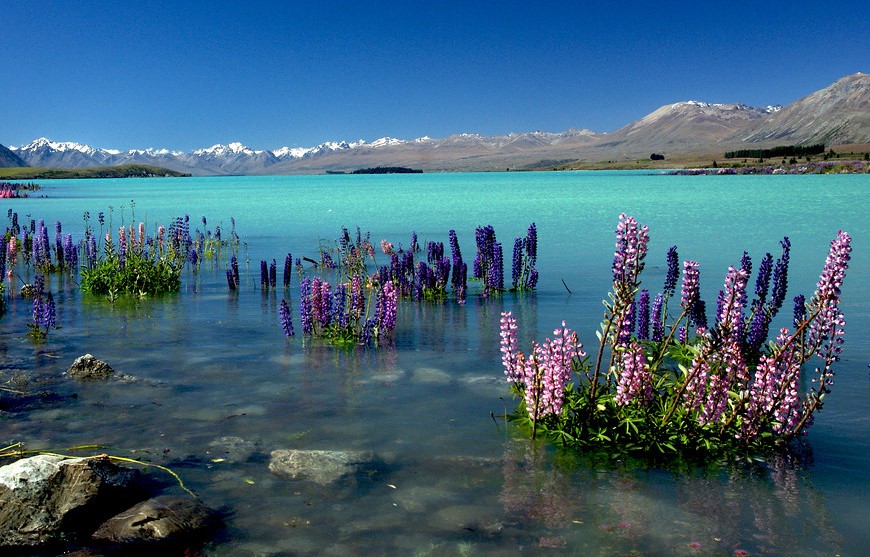
Lake Tekapo
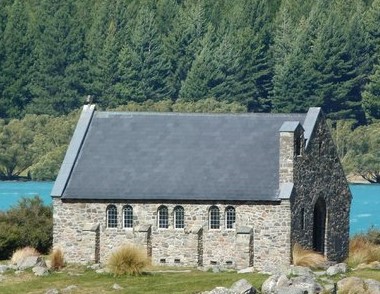
Church of the Good Shepherd in Lake Tekapo
We (Michael and Nancy) had spent a couple of days in Lake Tekapo in 2014. It’s a tiny town (population about 550), but the largest in the Mackenzie Basin, an area known not only for its historic sheep stations but also for meteorological conditions that make it uniquely suitable for astronomical studies. When we descended into the Mackenzie Basin for the first time in 2014, it was almost like entering Camelot: the dreary gray clouds blanketing the whole region on the other side of the surrounding mountains suddenly disappeared, and brilliant sunlight glittered across the light-aqua surface of the lake. After the sun went down, millions of stars appeared overhead, like diamonds scattered across black velvet. The town of Lake Tekapo is the gatekeeper for the world’s largest and probably clearest Dark Sky Reserve, and its residents take great pains to keep the sky unpolluted by artificial light for astronomers at the University of Canterbury’s Mount John Observatory and other research facilities in the basin. (We wouldn’t get to enjoy the stars on this visit to Lake Tekapo, but you can click here to read about our evening at the observatory in 2014.)
On New Year’s Day 2021, we found a parking space in the center of town and got in line for brunch at the Greedy Cow Café. It seemed as though everyone else driving across the middle of the South Island had decided to stop at the Greedy Cow, too—perhaps because it was one of the few places that was open on this holiday, but probably because it has a solid reputation for good coffee and bakery items. We can’t comment on the coffee, but most of the bakery items met our expectations. Michael was happy with his fruit-topped French toast with streaky bacon, and Barry pronounced his avocado toast excellent, but Nancy was disappointed with the Croque Madame she ordered because the toast was overdone and therefore needed more béchamel sauce. (Next time, she’ll order the avocado toast.) After sauntering up the street and browsing through the few shops that were open, we were on our way again.
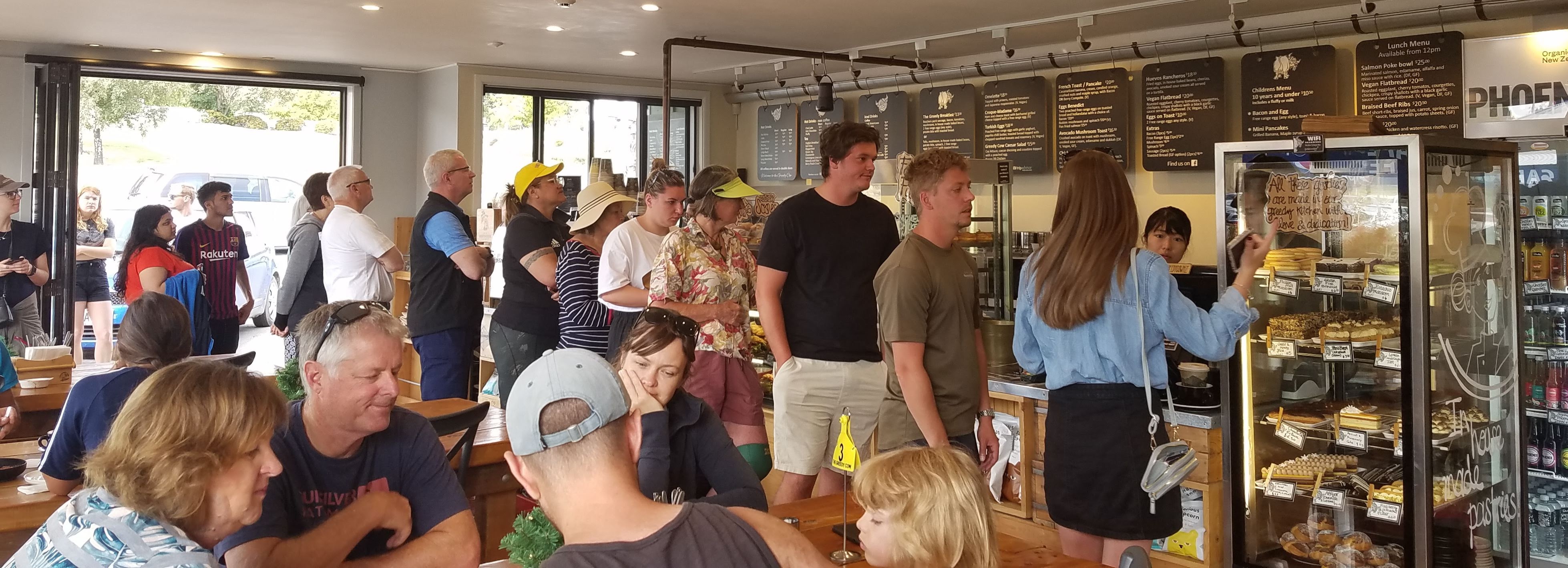
New Year’s Day at the Greedy Cow Café
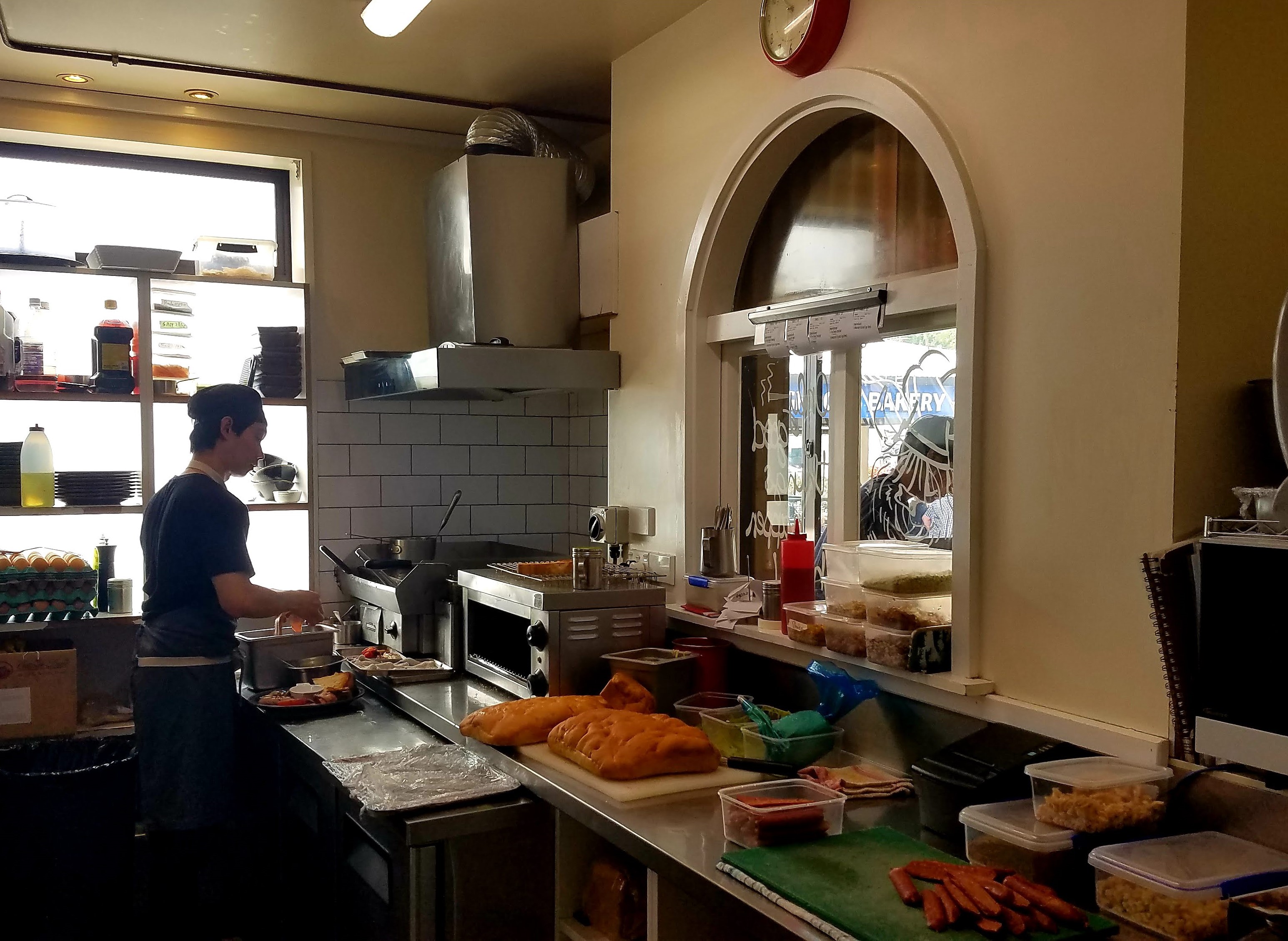
They needed more than one cook in the kitchen!
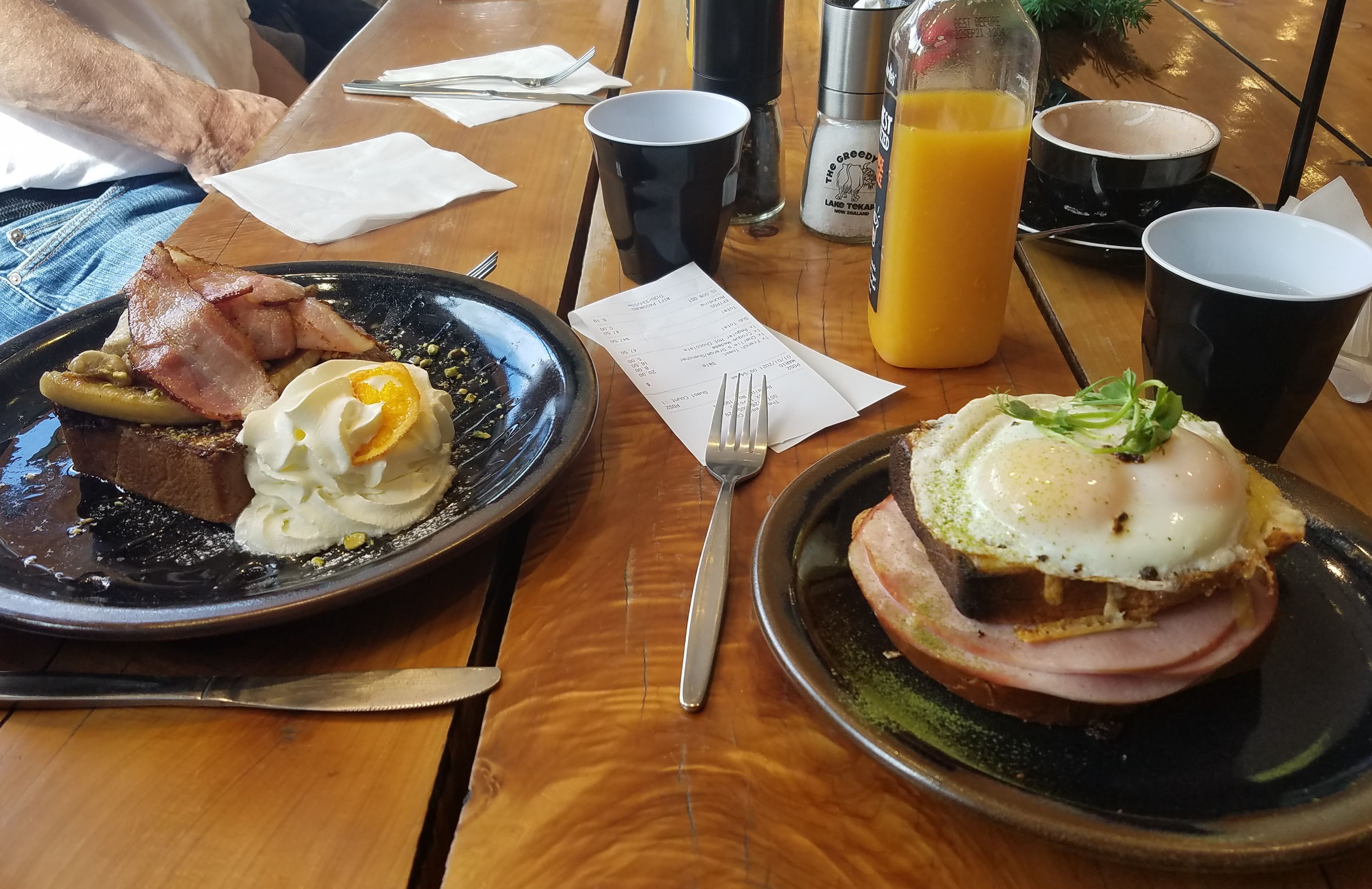
French Toast and Croque Madame
With only three hours of drive time left before we got to Christchurch, Eva decided not to pipe another audiobook through the van’s sound system; instead, she began sharing some of the music stored on her old iPod. The playlist she selected included a lot of vintage Mormon pop songs, sparking a conversation about how the Latter-day Saint musical landscape has evolved since the late 1970s when Denny Crockett started writing music for teenage seminary students that didn’t sound like hymns. Last year, our missionary cohort had enjoyed listening to the International Youth Music Festival, a virtual concert that premiered in July. We stood all amazed that the Church would produce a video featuring music with a distinct dance beat and performers sporting skinny jeans, dreadlocks, and inch-long black fingernails. (We’ve shown that video several times during youth programs at the Matthew Cowley Pacific Church History Centre and are happy that the Church has expanded its definition of “worthy music.”)

Airport Palms Motel in Christchurch
We drove directly to the Airport Palms Motel when we arrived in Christchurch around 2:30 p.m. so we could check in and unload our luggage before heading to a different part of the city for the remainder of the day. The motel was on a quiet street only a kilometer from the airport, which is why Michael had chosen it; we would have to leave early for our flight the next morning, and didn’t want to waste any time crossing town. The motel was small, but the rooms themselves were spacious, well-equipped, spotless, and modestly priced. When we got back in the van to proceed to our next activity, Diane (a seasoned world traveler) remarked, “When I book a room somewhere, I normally don’t even think about looking at small places like this, but I’ll have to rethink that strategy in the future. This place is really nice!”
The next item on our agenda was a gondola ride up Mount Cavendish, one of the Port Hills overlooking the city of Christchurch and its spectacular maritime setting. Eva and Nancy had hoped we would take advantage of a package deal that included punting on the Avon River along with the gondola ride. Relaxing in the bow of a little boat while someone else rowed through the Avon’s placid water sounded like an ideal way to see the city, but the punting expedition was nixed because it would have required driving miles in the opposite direction from our destination for the evening. So we contented ourselves with taking the gondola to the top of Mount Cavendish, where we could enjoy the panorama of city, mountains, harbor, and ocean before clouds began rolling in and obscured the view. We wished we had gone prepared to hike, because we could see a number of nice trails up the steep hillside and along the rim of the volcanic crater that forms Lyttelton Harbour on the south side of the city.
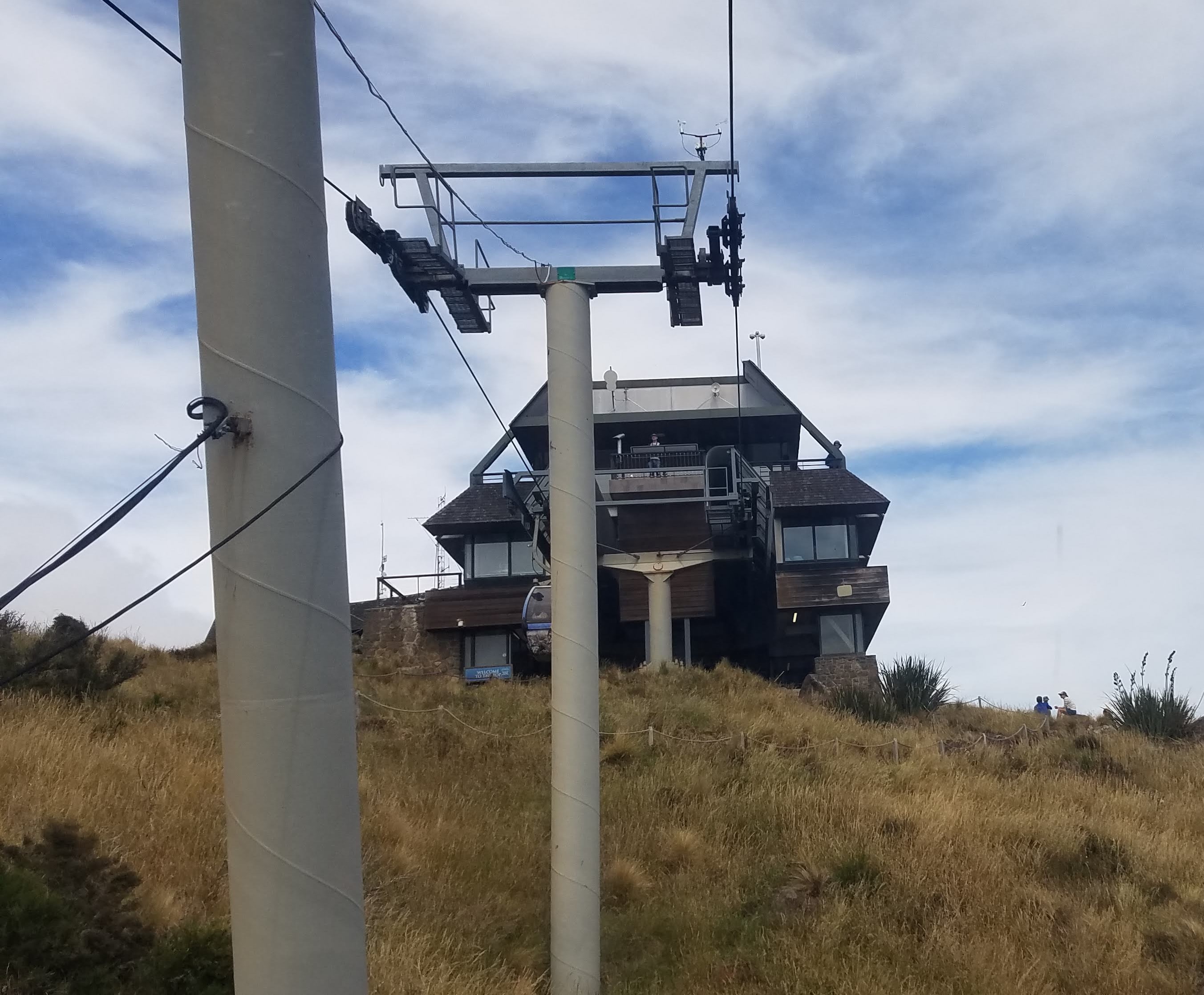
Riding to the top of Mount Cavendish
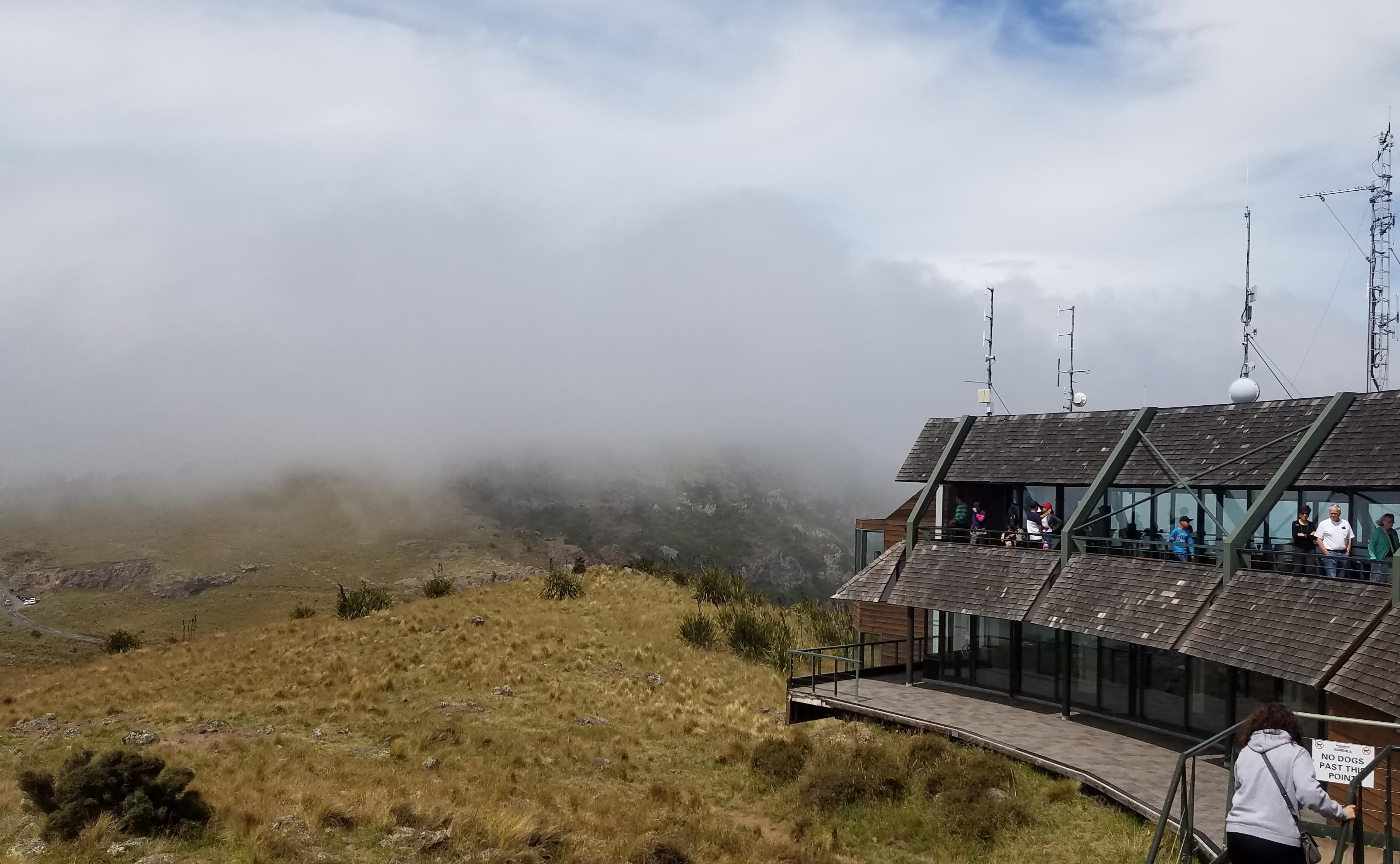
A low-hanging cloud blocked the view on one side of the observation deck
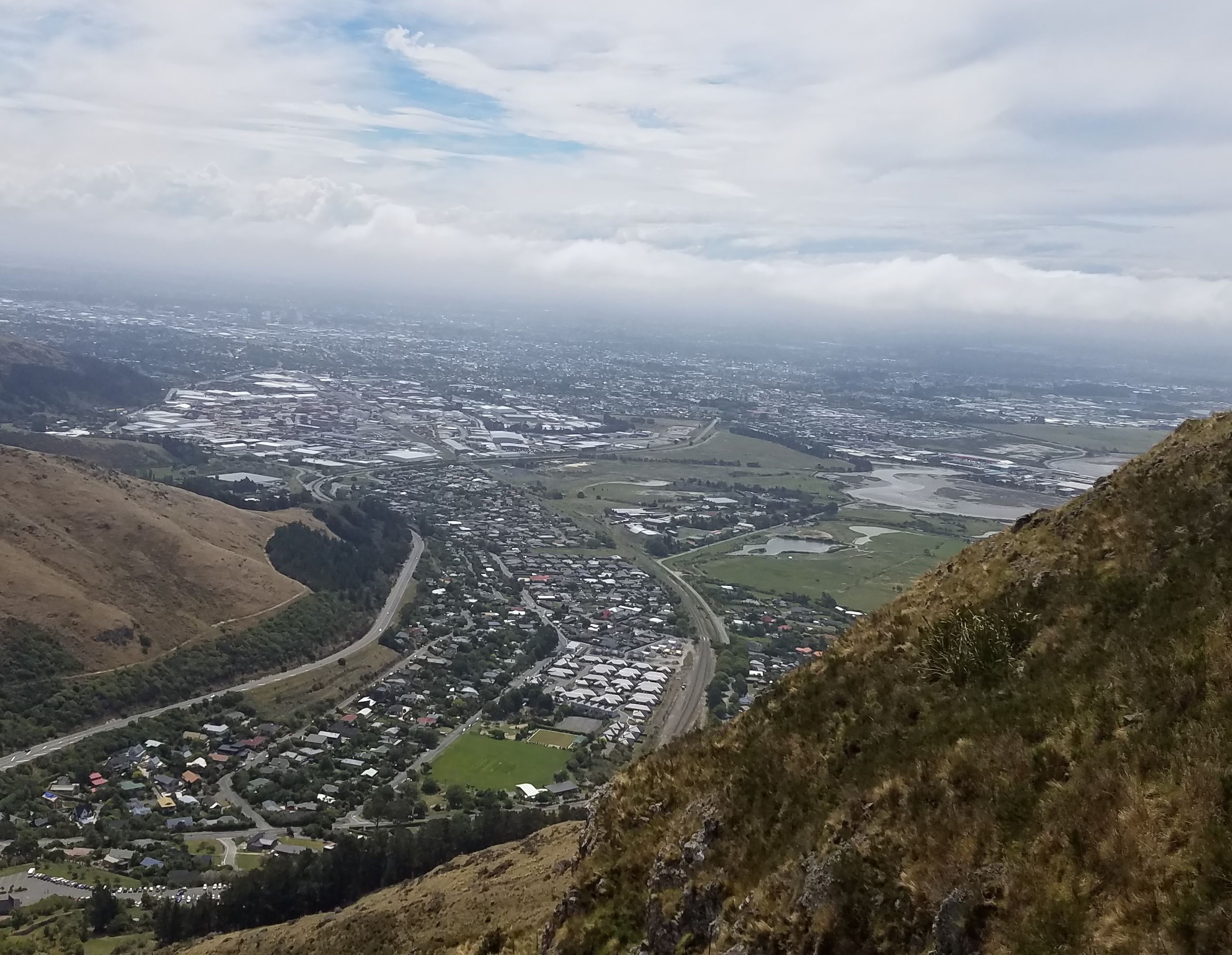
Christchurch from Mount Cavendish
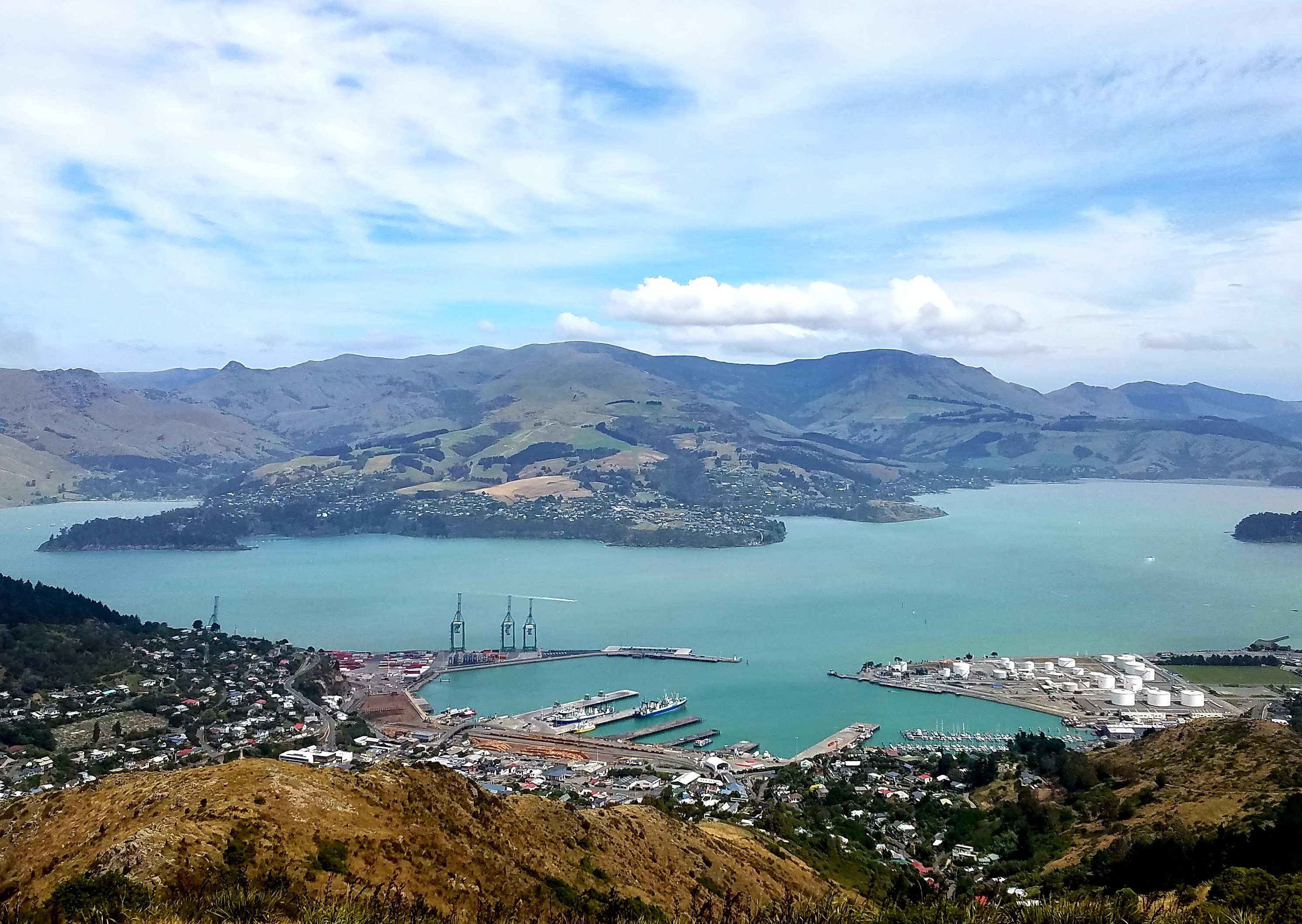
Lyttelton Harbour on the back side of the Banks Peninsula
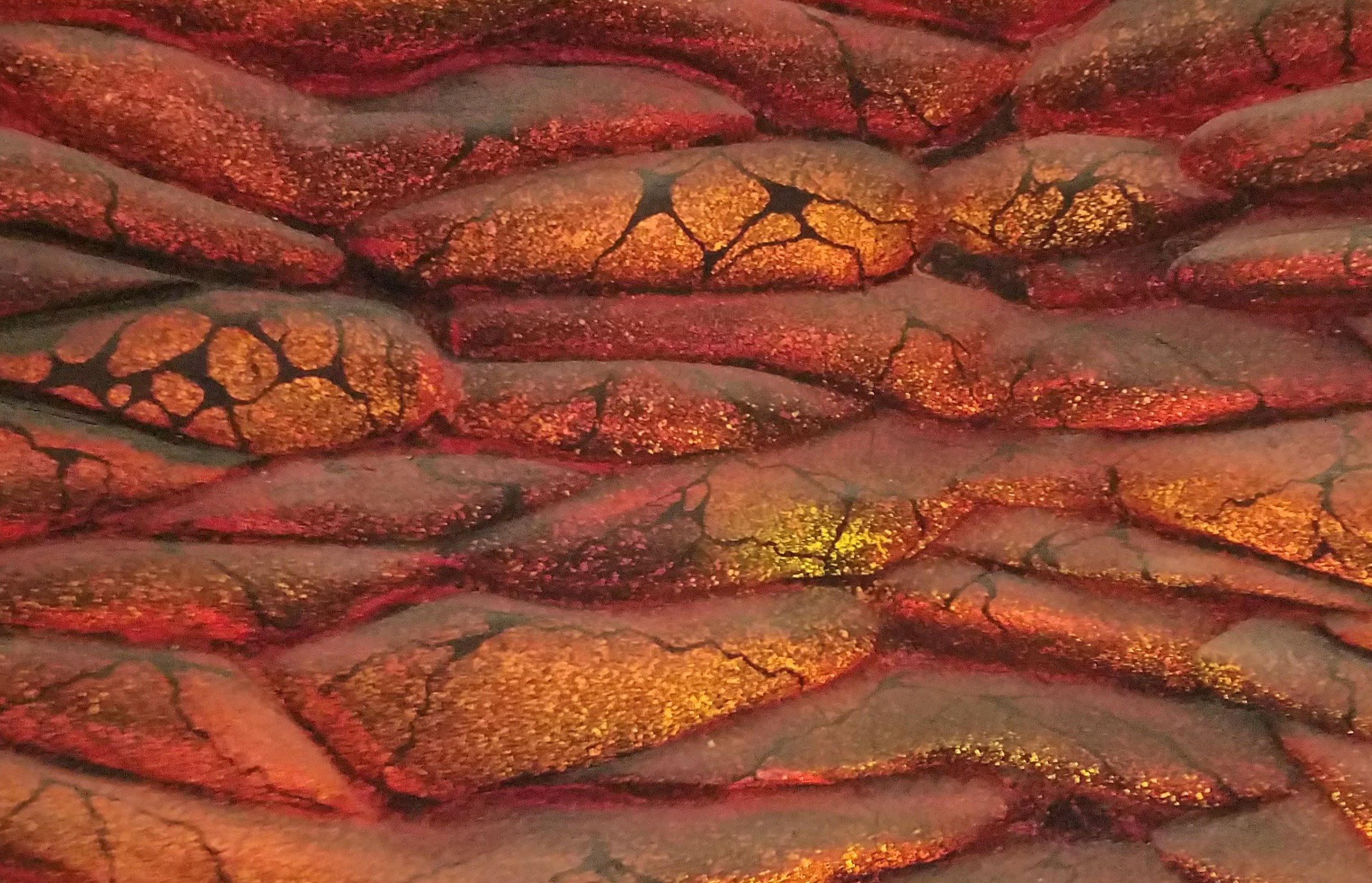
A wall inside the Heritage Time Tunnel representing the volcanic action that formed Lyttelton Harbour and the Banks Peninsula
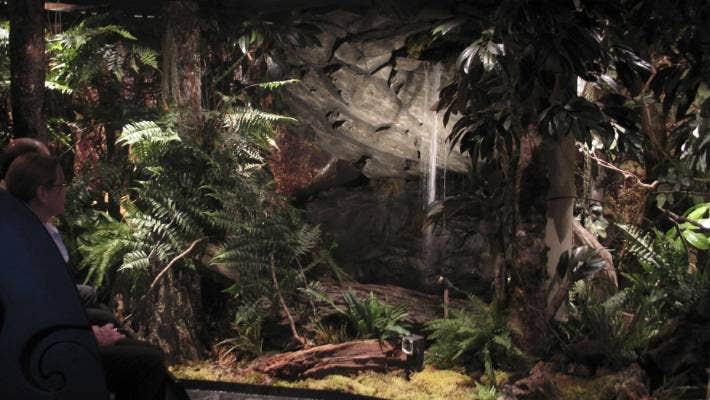
Prehistoric times in the Christchurch area. Unfortunately, this photo does not include the model of a giant moa—an extinct flightless bird—that lunges at visitors as they ride through the Time Tunnel
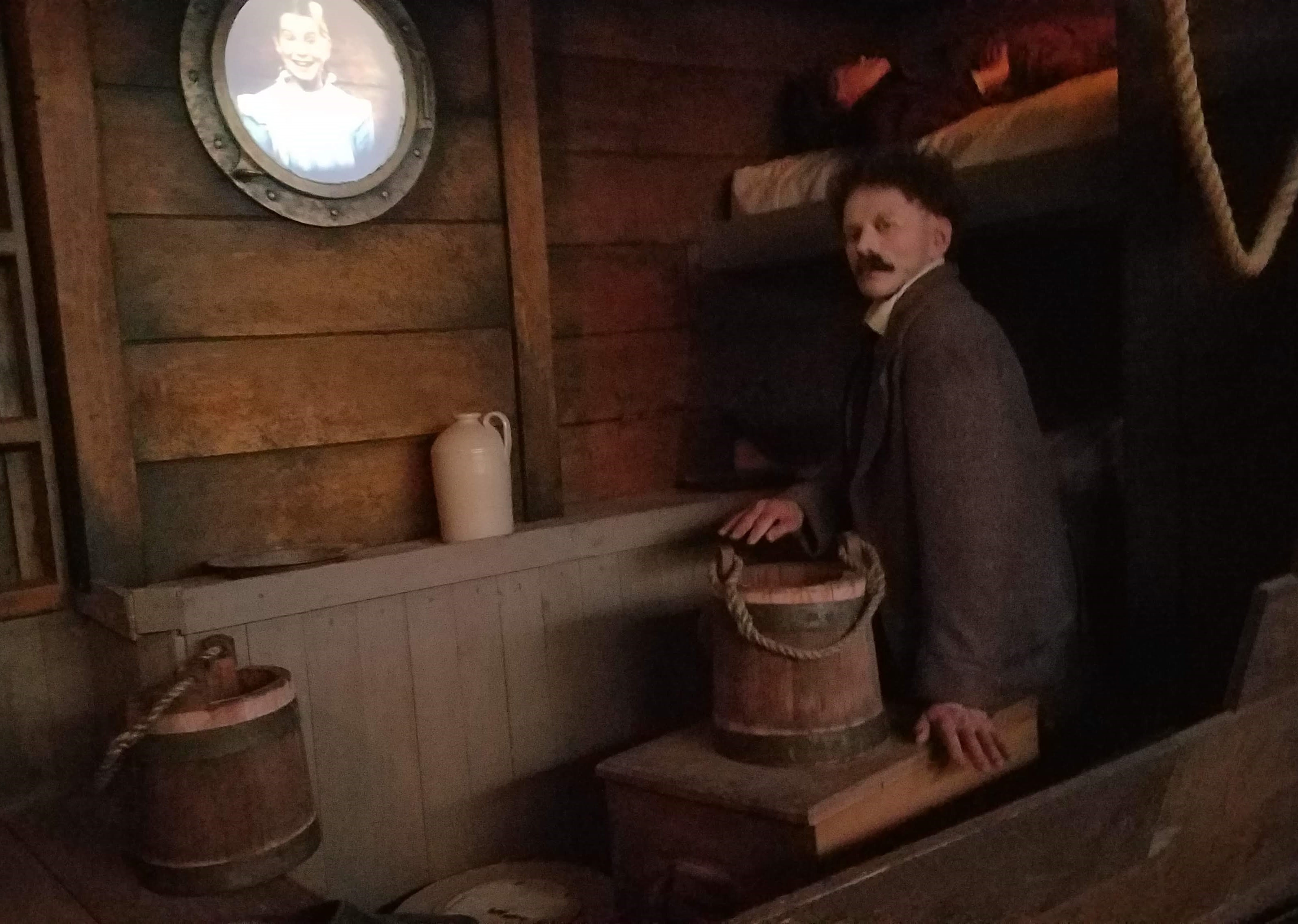
A diorama in the Time Tunnel represents a ship that brought European settlers to Christchurch. (That’s Olivia appearing in the porthole)
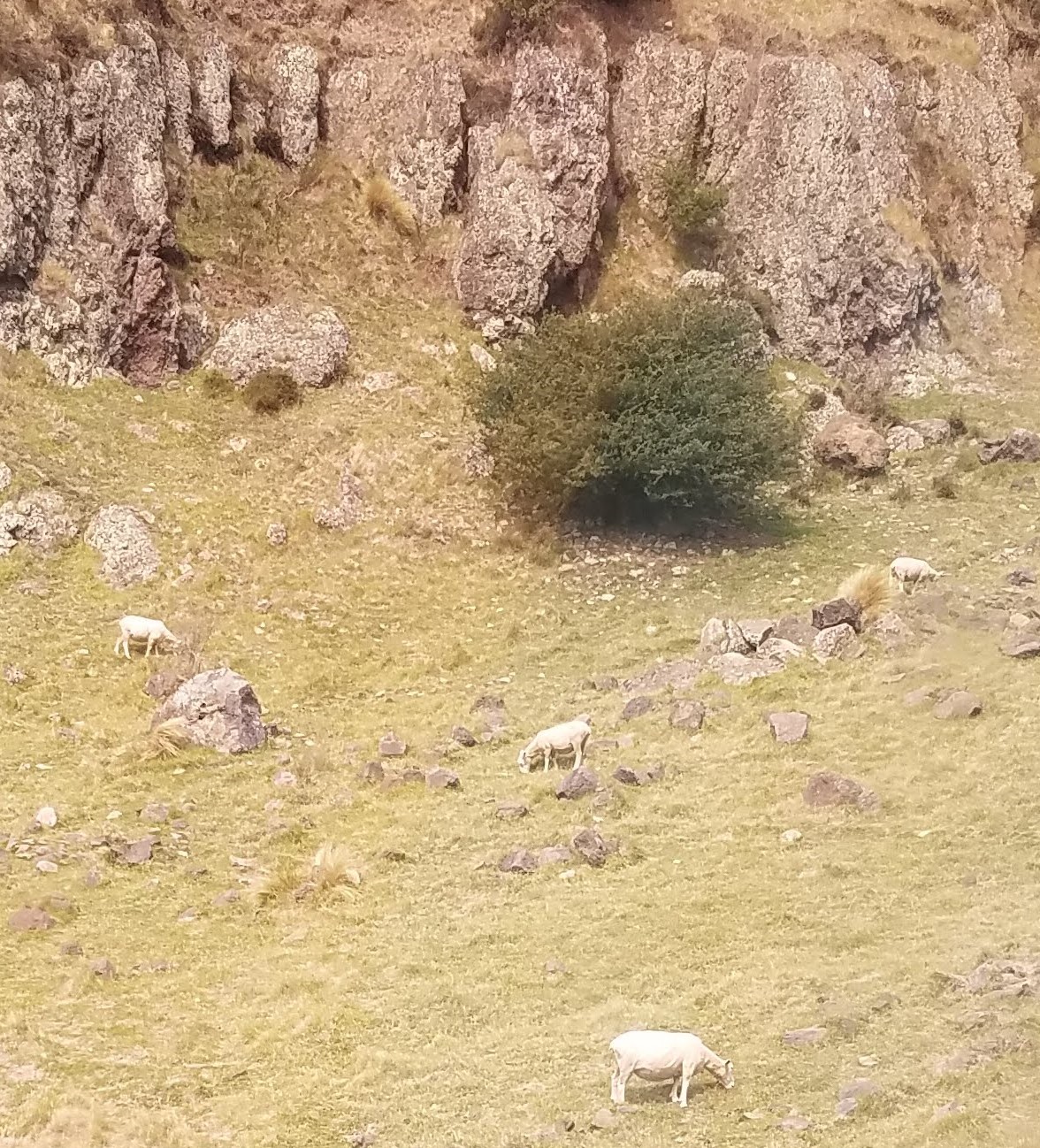
The gondola glided over a herd of grazing goats during our descent of Mount Cavendish
When we’d had enough of the wind that whipped around the observation deck, we went inside and visited the Heritage Time Tunnel, an “attraction” included in the cost of the gondola ride that takes visitors on a seven-minute journey through the history of the Canterbury Region. A series of dioramas represents various historical eras, from the prehistoric “fiery volcanic bursts” that produced the region’s geological features to the establishment of Christchurch by European settlers in 1856. The ride is narrated by a blonde, blue-eyed teenager with a slightly annoying voice; she introduces herself as Olivia and appears on video in each successive room wearing a different historical costume and hairdo. The Time Tunnel experience ends up with a video presentation called “Gallery of Achievers,” showcasing some of Canterbury’s brightest lights. That we had not previously heard of any of these people may or may not indicate our own level of ignorance: Richard Pearse, dubiously described as “first to achieve powered flight”; Jack Lovelock, the 1936 Olympic gold medalist in the 1500 metres; cricket legend Sir Richard Hadlee (“first bowler to pass 400 test wickets,” whatever that means); and soprano Hayley Westenra, who in 2007 released Pure, “the fastest selling international classical debut album of all time.” Olivia concludes the tour by quoting Sir Edmund Hillary (who was from Auckland): “People do not decide to become extraordinary; they decide to accomplish extraordinary things.” Then she goes on, “We now have an extraordinary opportunity to create a new city, a place for ourselves and for future generations to achieve our dreams!” Frankly, we think the company that dreamed up the Heritage Time Tunnel fell considerably short of an extraordinary achievement, but it did add some variety to our afternoon.
We didn’t have to worry about finding a restaurant that would be open for dinner on New Year’s Day because we had been invited to the home of Melanie R-C, the woman who had just been hired as the manager of the Church History Department’s Pacific Area operations. This is not a missionary assignment, but a full-time, paid position, and although we had met Melanie only once, when she came to Hamilton to interview for the job, all of us were thrilled that she was the one selected. We were equally thrilled when she invited us to join her family for dinner after we asked her to recommend a Christchurch restaurant that might be open on a holiday.
It was about 4:30 when we got back to the base of the gondola, and Melanie and family were not expecting us until 6:00, so we stopped at a petrol station to refill the van’s fuel tank, went to New World to buy a bunch of flowers and a couple of bottles of sparkling feijoa/apple/lemon juice to present to our hosts, and then drove to nearby Hansen Park, where there was a public toilet and a nice footpath along the Heathcote River.
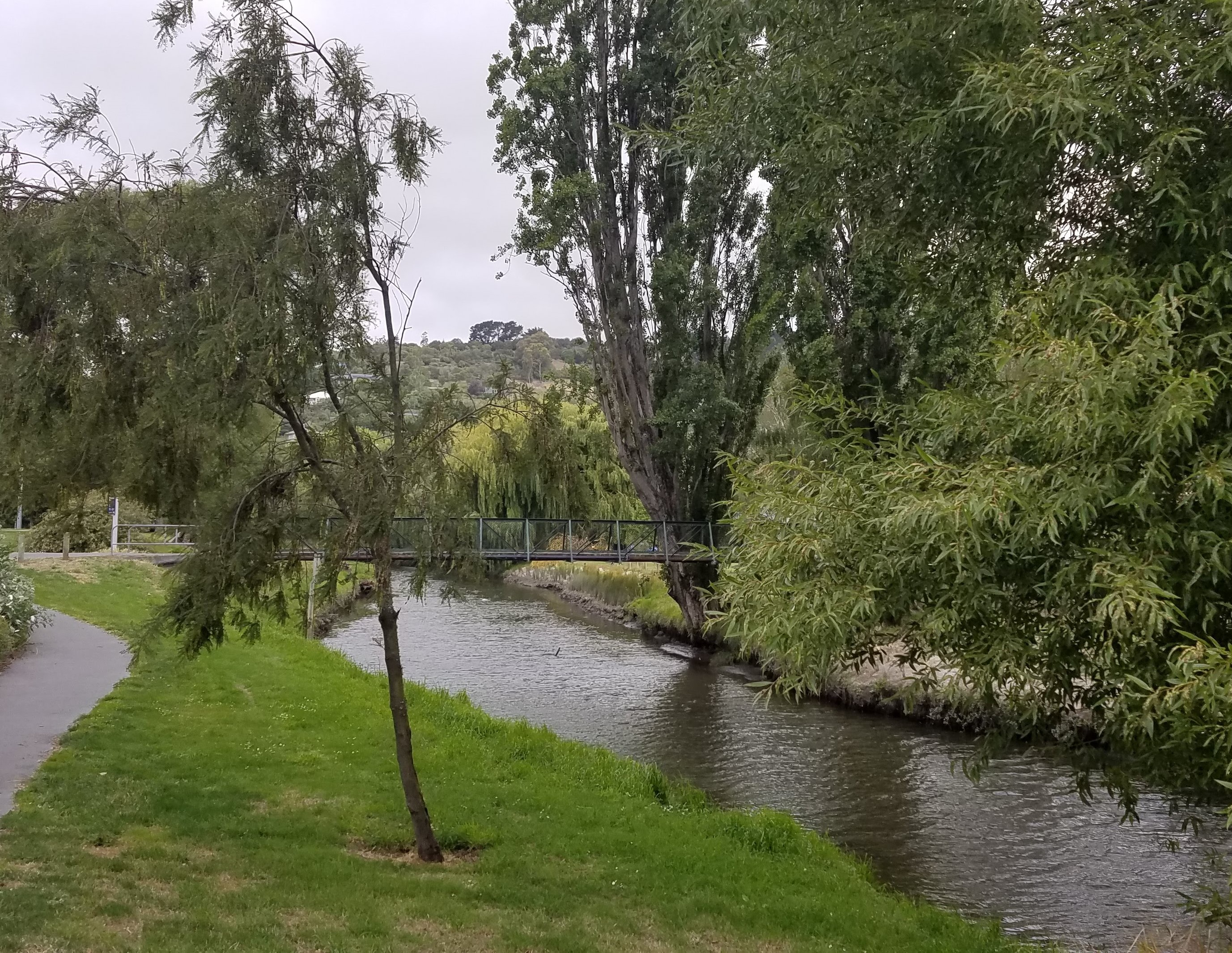
The Heathcote River behind Hansen Park
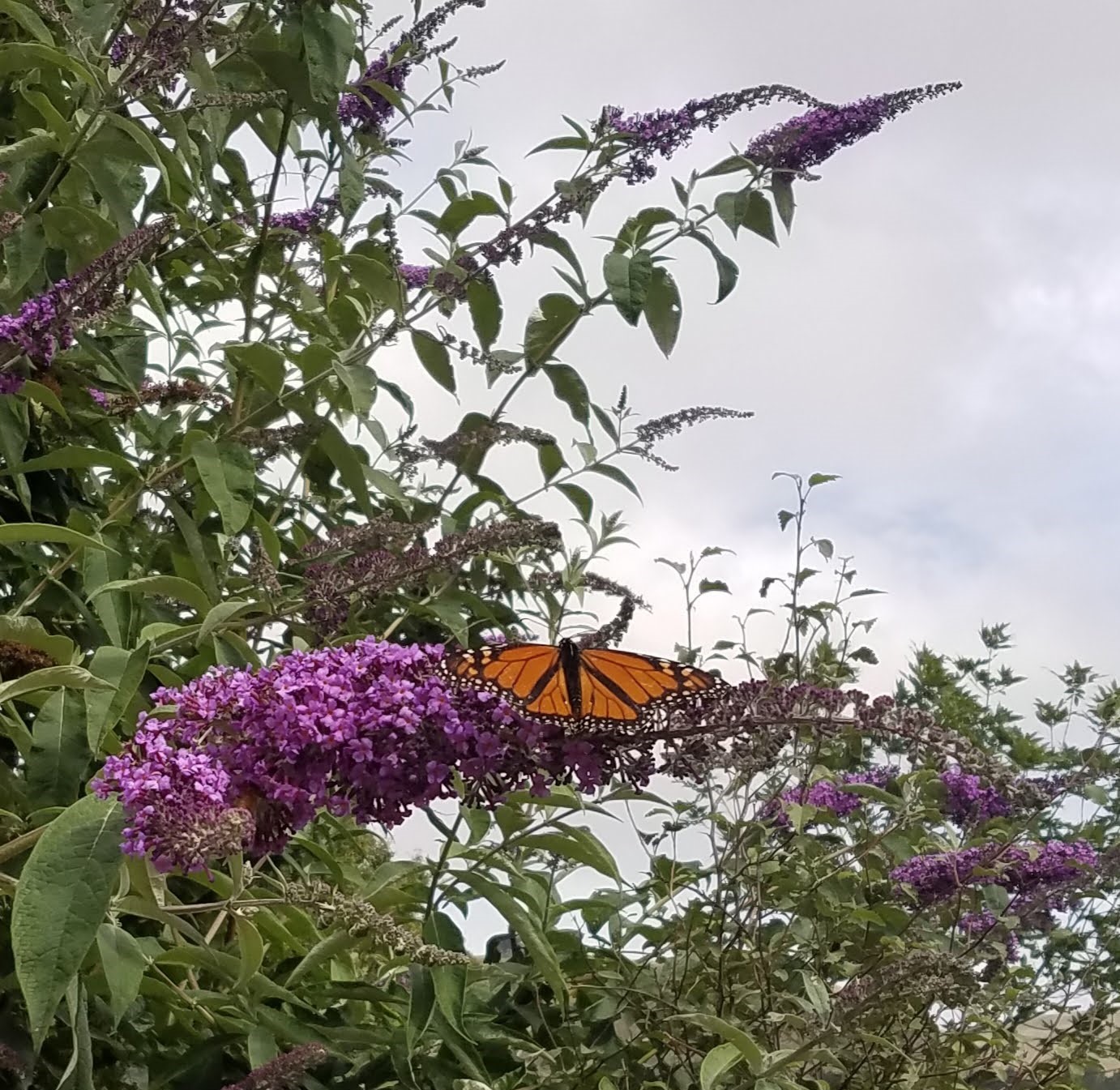
The butterfly bushes in Hansen Park were doing their job
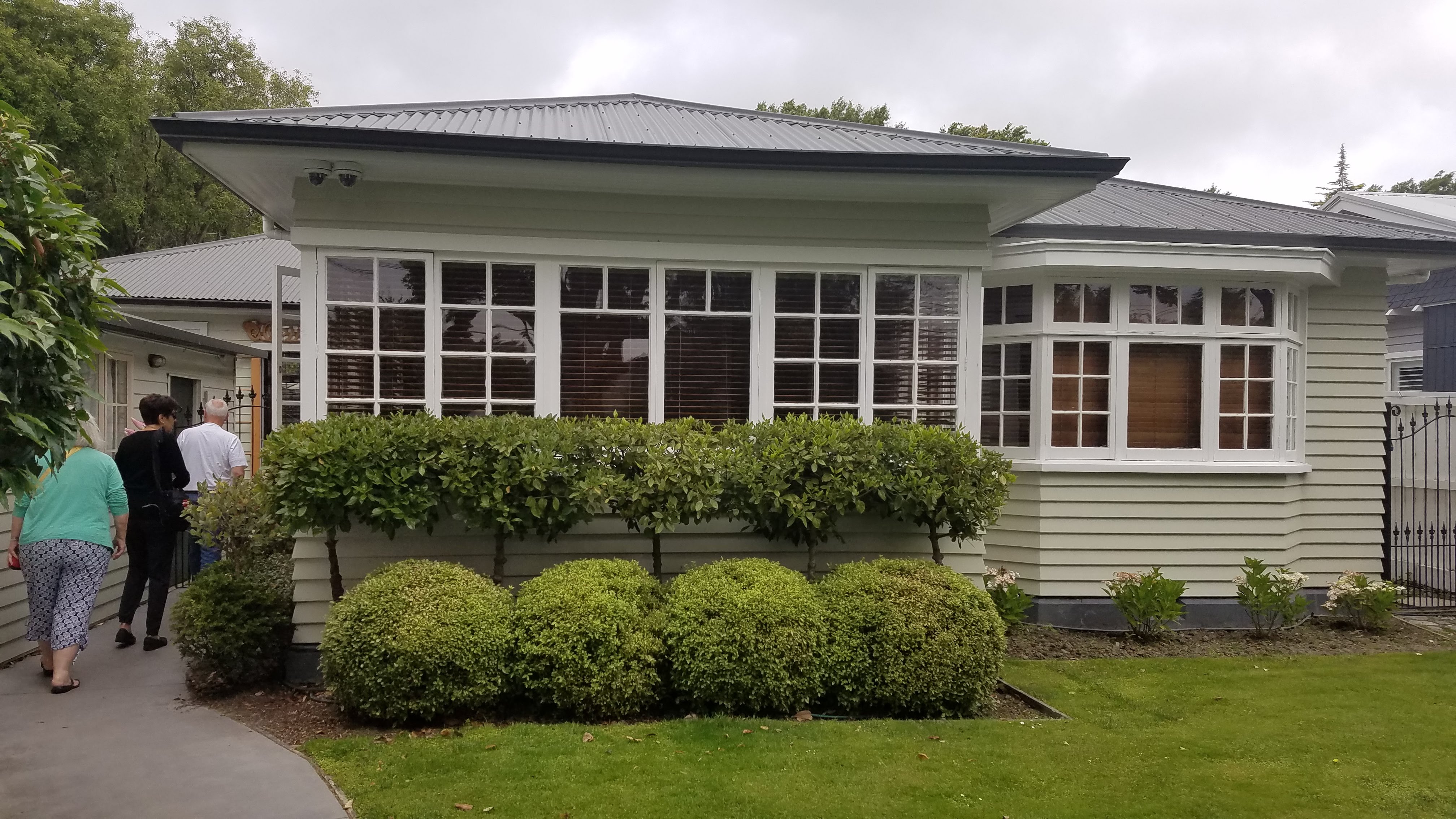
Melanie and Jared’s home in Christchurch
Our evening with Melanie and her family provided a much needed counterbalance to the overwhelmingly Pākehā (European) cultural history presented in the Heritage Time Tunnel, where the only Māori portrayed were a group of primitive hunter-gatherers from the precolonial era. Both Melanie and her husband, Jared, are Māori, and both are committed to raising their five children with a deeper understanding of their cultural heritage than either of them were able to achieve while they were growing up. Jason’s grandfather had been one of the first Māori elected to Parliament by the National Party and served as Minister of Māori Affairs during the 1980s, when Māori were seeking legal redress for rights and property lost more than a century earlier as the Pākehā majority exploited loopholes in the 1840 Waitangi Treaty. Jared and Melanie began attending school just as speaking te reo (Māori language) was regaining acceptance after a long period of official suppression, and as appreciation of Māori culture was beginning to be included in the curriculum of some New Zealand schools. Melanie described how attending the Church College of New Zealand had awakened in her a desire to learn more about her culture as well as her religion, and then to be able to teach others to embrace their language and heritage. Prior to becoming the regional Church History manager, Melanie, who holds a PhD in education from the University of Canterbury, had been principal of a Māori immersion school and an educational consultant who helped other institutions integrate Māori language, culture, and values into their curriculum. For his part, Jared counsels youth who get in trouble with the law, in addition to running a business designing and constructing korowai (Māori ceremonial cloaks). At church, the couple serves as advisers to their ward’s Young Single Adult group.
Although Melanie and Jared’s five children may not yet have resumes as impressive as those of their parents, we have no doubt that someday they will. We did not meet their oldest son, Brigham, who was about to return home from a mission and resume playing national-level rugby, nor Mei, their oldest daughter, who was out for the evening with her boyfriend. But we thoroughly enjoyed engaging in conversation with Eden (16), Manu (13), and Makere (11), none of whom acted as though spending the evening with their parents and five senior missionaries was an utter bore.
When she invited us to dinner a few weeks ago, Melanie mentioned that homemade pizza baked in their backyard wood-fired oven was likely to be on the menu, so initially we were a little disappointed when she explained that they had had to change plans, but the alternative menu was wonderful: ham, salmon fettuccine, green salad, kumara/potato/orange salad, and a big bowl of the largest, most delicious fresh cherries we’d ever eaten.
For dessert, Melanie had made ambrosia. This mixture of whipped cream, yogurt, berries, marshmallows, and shaved chocolate is a Kiwi favorite, but—like Americans’ potato salad—there’s no standard recipe, so no one makes it the same way as anyone else. Dessert also included a commercially-baked cake that Mei’s boyfriend had brought over when he picked her up. Both the cake and the frosting were an odd mauve color and none of us could determine what flavor it was, but it was pretty good and paired nicely with the ambrosia.
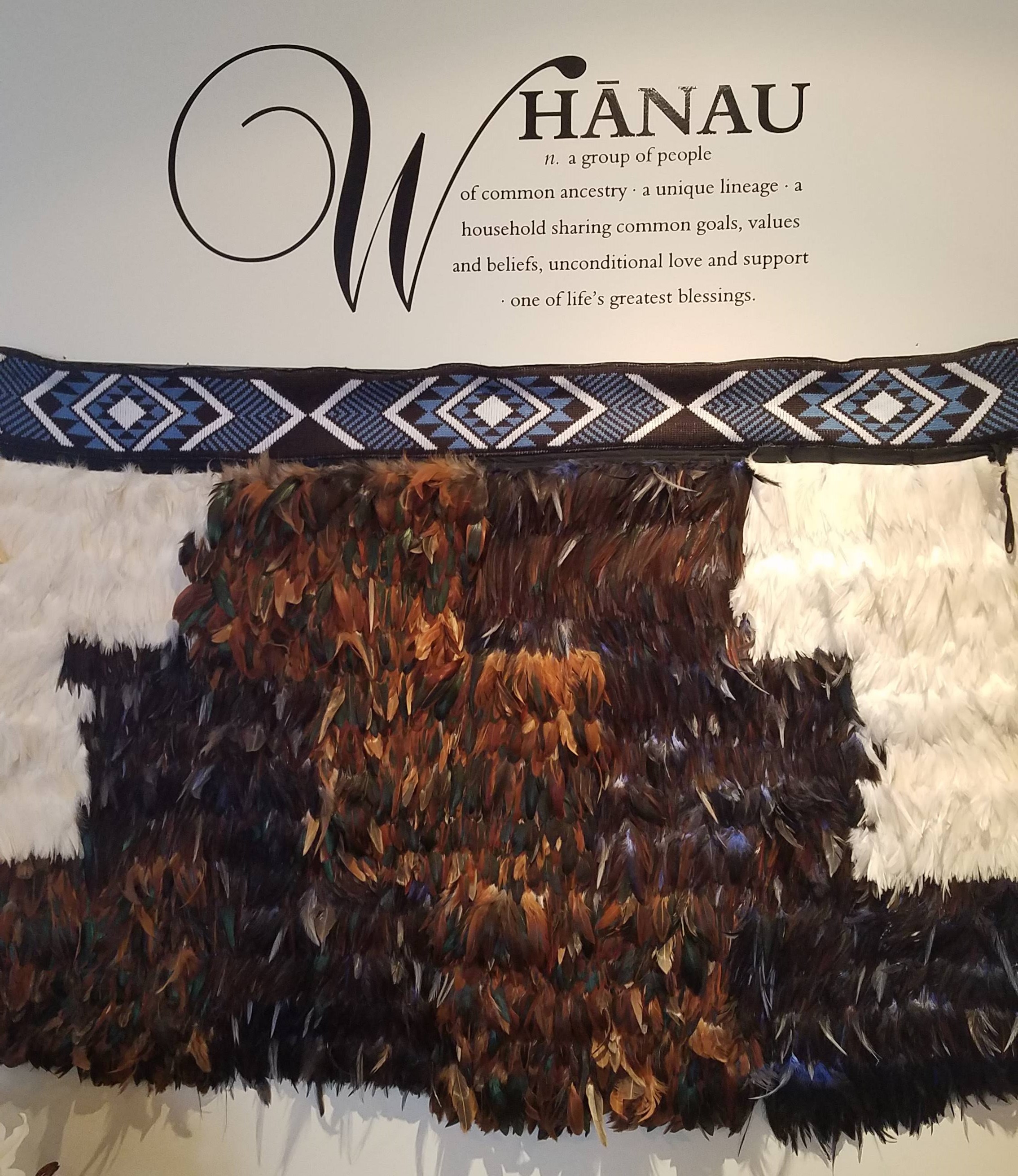
One of Jared’s korowai is part of a wall display honoring the family’s heritage

Manu, Jared, Melanie, Makere, and Eden pose with the tapa that covers one wall of their lounge. It was presented to Jared by the family of a young man he had counseled
After they helped clear away the dinner dishes, the children slipped off to their rooms to change into fancier clothes for a church New Year’s Dance. Meanwhile, knowing that we would have to be at the airport early the next morning, Melanie insisted on preparing packages of cereal, yogurt, and fruit for us to take back to our motel for breakfast—another manifestation of the thoughtful hospitality we had experienced all evening and that is a hallmark of Māori culture.
About 8:00 we exchanged farewell hugs with everyone, and then, on her way to take the kids to the dance, Melanie led us a few blocks down the street to the Ashgrove Reserve. This is a small grove of totara, kahikatea, kauri, and other native trees that the city and a local residents’ association have been nurturing for nearly sixty years. Melanie told us that she and Jared sometimes bring their YSA group to the Reserve for devotional meetings, and after walking around the peaceful grove for a while before sunset, we could understand why.
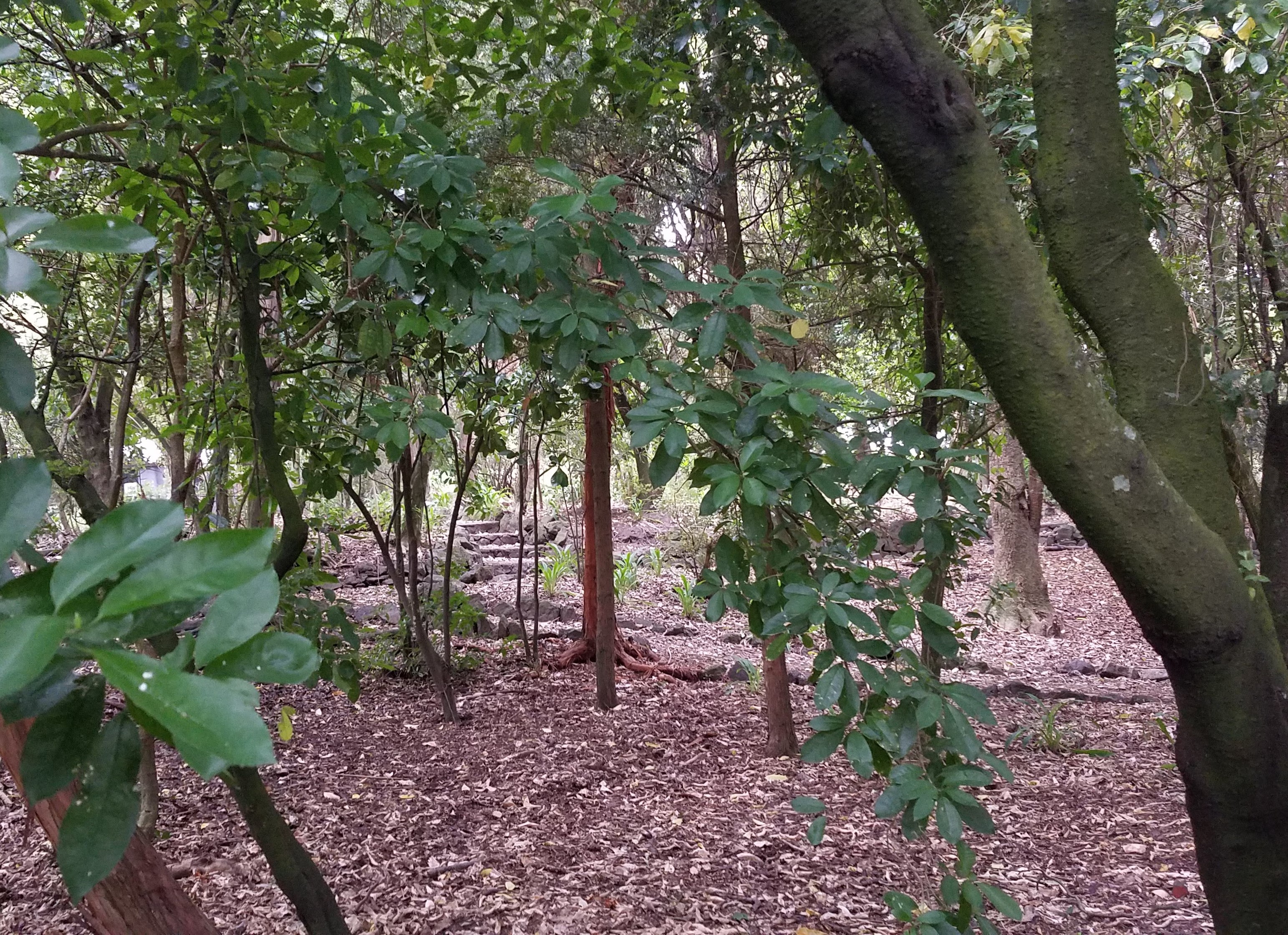
Ashgrove Reserve
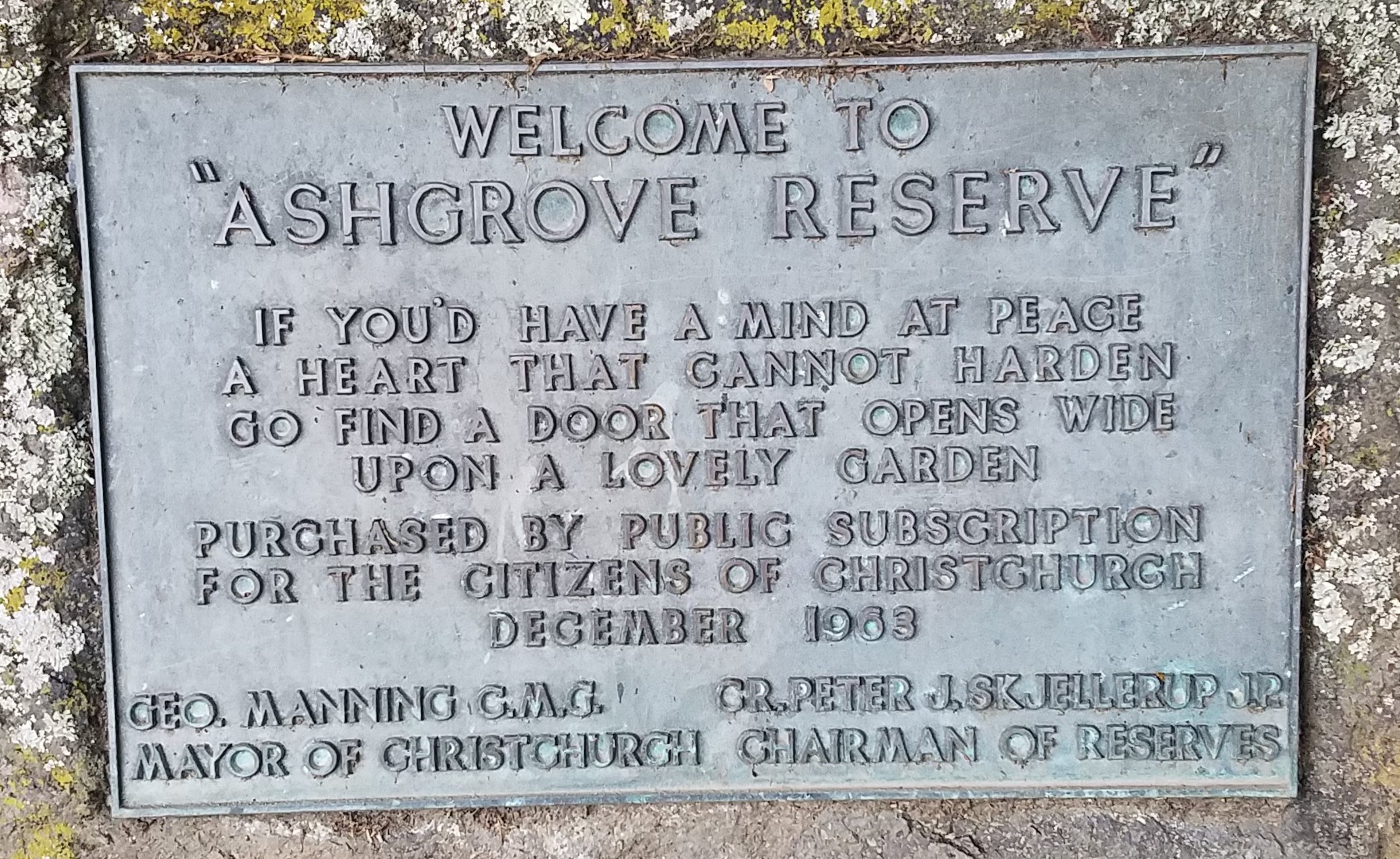
Plaque at the entrance to the Ashgrove Reserve
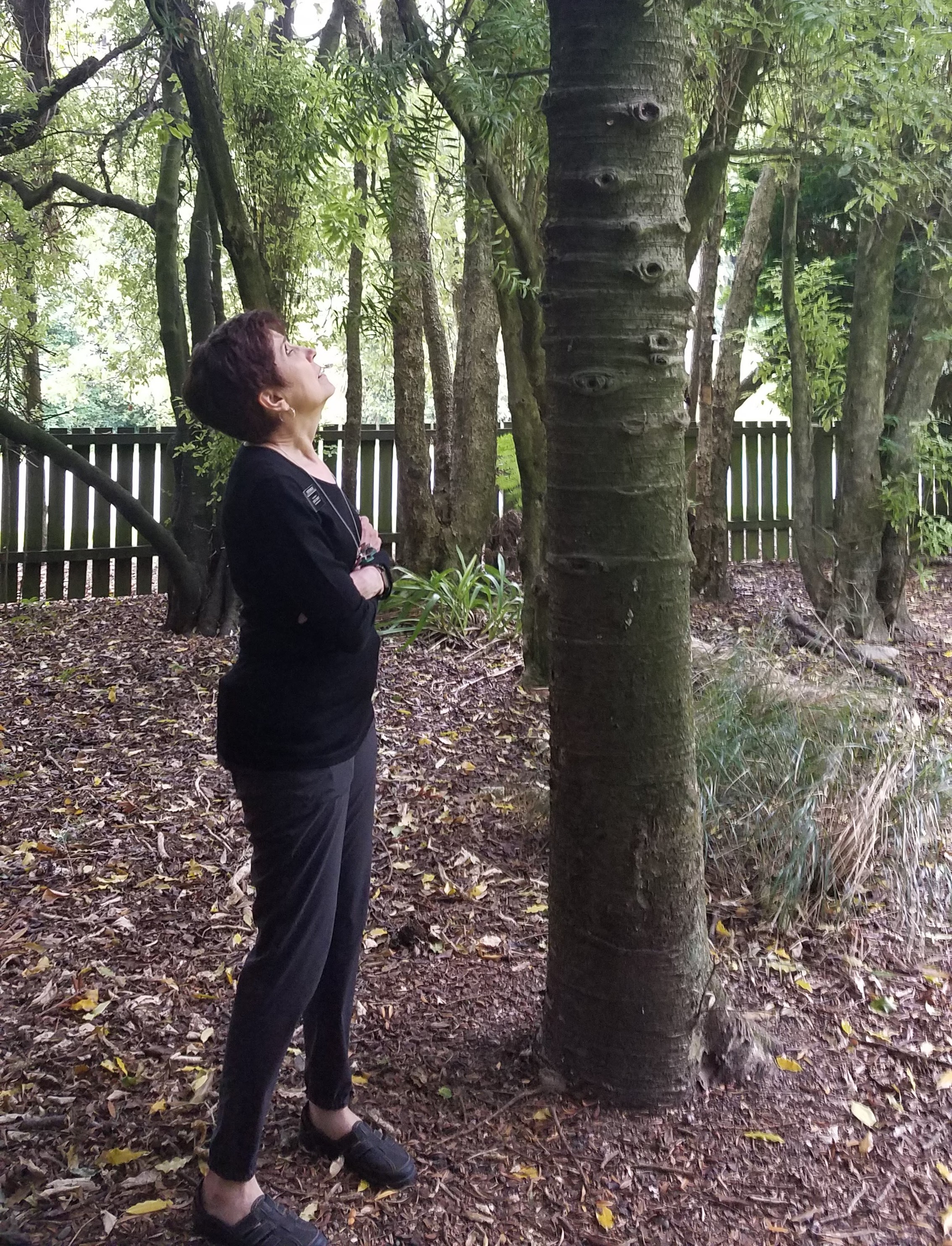
Eva examines the unusual growth pattern on the trunk of a relatively young kauri tree
Back at the Airport Palms Motel, we regrouped and repacked so we would be ready to leave for our 9:00 a.m. flight the next morning. The plane was late leaving, but otherwise the flight was uneventful. When we landed in Hamilton, we found the weather gray and rainy; that afternoon it turned muggy and warm, and we again gave thanks for the miracle of so much sunshine during our trip.
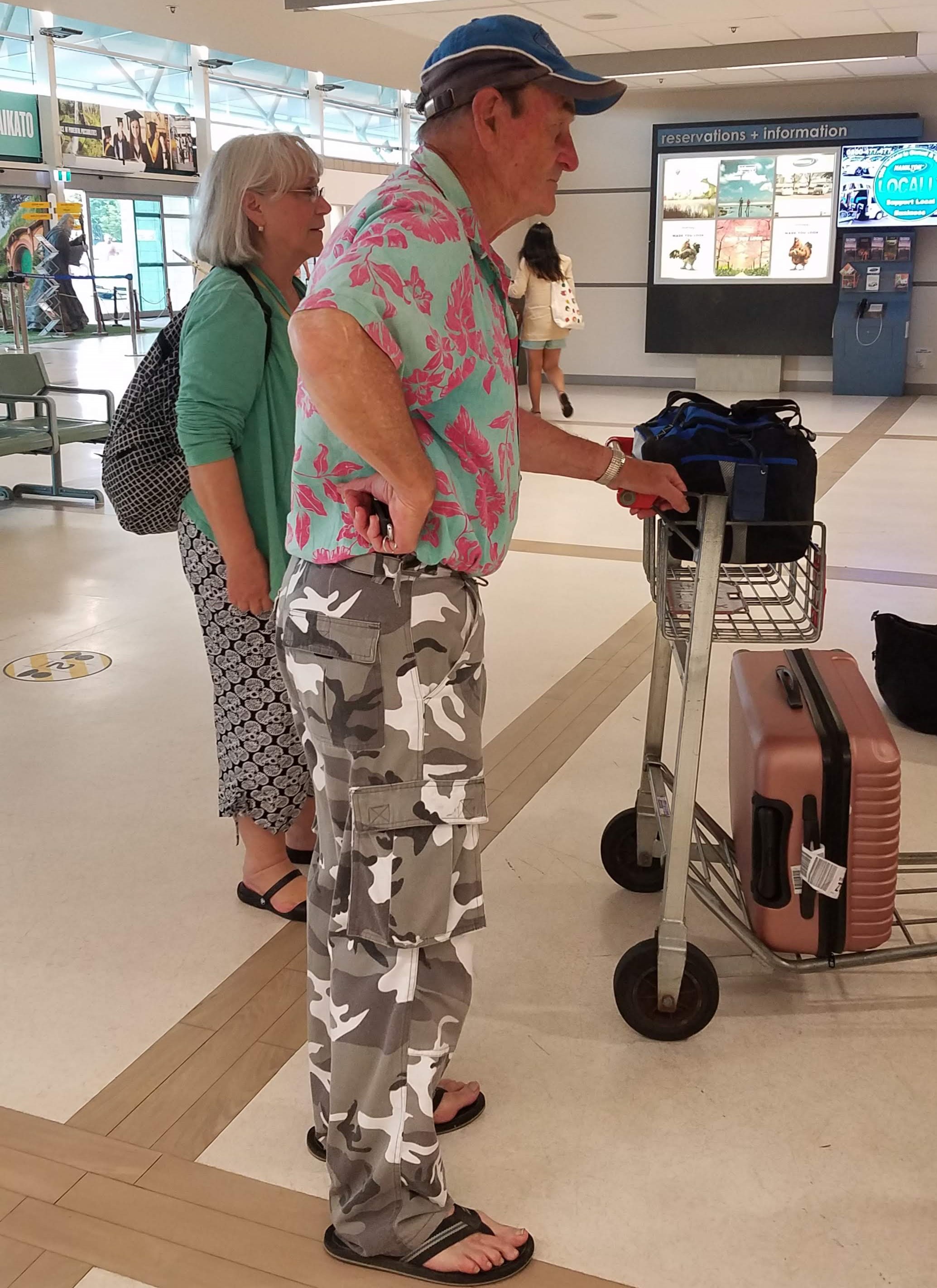
Diane and Vic (who was waiting in the terminal to take us home) at the Hamilton Airport
We also gave thanks for wonderful traveling companions. This would be our last trip with Barry and Eva, whose tenure as directors of the Matthew Cowley Pacific Church History Centre was coming to an end on 15 January. Several months earlier, when COVID-19 was spreading completely uncontrolled in the U.S., Elder and Sister G decided that they weren’t ready to go back to Utah and applied for another mission so they could stay in New Zealand until June 2022. Barry now has been called to serve as executive secretary to the president of the Church’s Pacific Area; Eva will serve as an administrative assistant in the Area office, which is located in Auckland. We will miss their presence at the MCPCHC and our daily association with these dear friends, but we’re glad that they won’t be too far away (less than two hours) so we can still get together periodically. And we’re happy that Diane (Sister E) has been granted a six-month extension of her mission so she won’t have to leave us quite so soon. We love the people we work with as much as we love New Zealand!
What a lovely end to a wonderful trip. The bonus of good friends and good weather added to meticulous planning made for a smooth and enjoyable adventure. Bravo!
What joyous experiences you are having. Glad Covid-19 has not Invaded spaces!
Miss you.
Carolyn Hahne